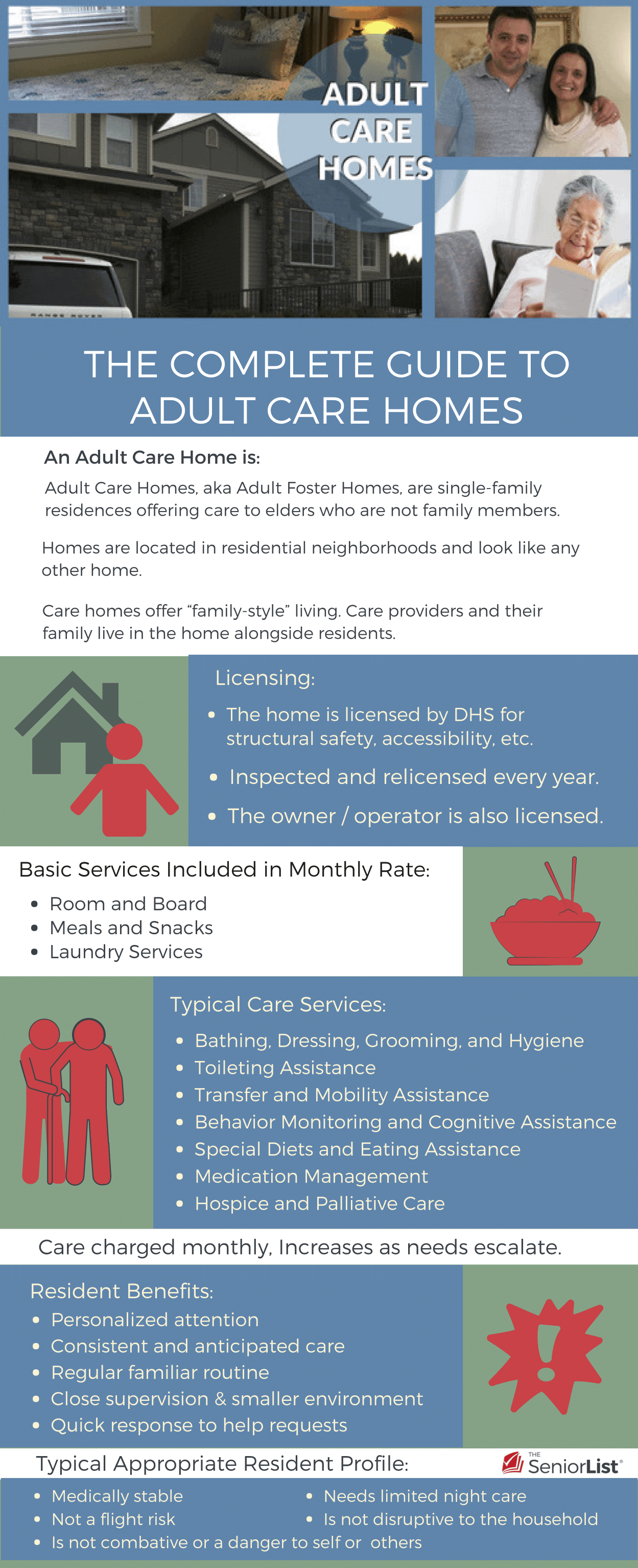What Are Adult Care Homes?
Adult care homes (also known as group homes or residential care homes) are single-family residences that offer care to seniors and people with disabilities. These homes are located in residential areas throughout the United States, and they offer an alternative to assisted living communities and nursing homes.
You may not even recognize an Adult Care Home in your neighborhood, as they look like any other home. Adult care homes are non-institutional. That’s why many of my clients choose a care home over assisted living, as they offer “family-style” living, which, for the right person, can feel more personal, warm, and welcoming.
Adult Care Homes Versus Assisted Living
While no two care homes are built exactly the same, they generally share many traits. Seniors receiving care are called residents, not patients, and on average, there are no more than five to ten residents at a time living in an ACH, and the staff-to-resident ratio is usually much higher than that of other types of senior care facilities.
In terms of personal care, some highly skilled Adult Care Homes specialize in bariatric care, ventilator care, recovery from cosmetic surgery, and psychiatric care. This level of care is often an excellent alternative to nursing homes; however, these types of facilities can be difficult to find in more rural parts of the country.
Many older adults transition to an adult care home setting from assisted living. My grandmother lived in assisted living for several years before “outgrowing” the level of care assisted living was able to provide. When compared to assisted living, care homes have a lot in common. They both offer meals, housekeeping, private or semi-private rooms, and 24-hour assistance with both everyday tasks and emergency situations. However, there are some key differences.
| Adult Care Homes | Assisted Living |
|---|---|
|
|
All About Adult Care Homes
While care homes feel low-key and home-like, they’re still highly regulated by state licensers, to a degree similar to that of nursing homes. Each home must be licensed and inspected for structural and safety concerns. The Department of Aging & Disability mandates basic home requirements such as:
- Square footage
- Accessibility
- Fire and safety systems
- Accessibility of caregivers
Management of Adult Care Homes
Each home’s owner and operator is also licensed. This person may have a background as a licensed medical professional, but this is not required. To qualify for licensing, the owner or operator must have a minimum of experience in providing elder care. Usually, they’ve worked in a nursing home or another type of elder care facility.
The homeowner is liable and responsible to follow all of the state rules and regulations. Providers must at least pass a criminal background check, complete basic training, and pass an English exam. Maintaining a license requires staying compliant and completing ongoing education each year.
Oftentimes, the home’s operator lives in the home and provides day-to-day care, but this will vary depending on the setting. In lieu of living onsite, they may hire qualified caregivers. The caregivers will either work part-time to cover days off or act as daily helpers. The owner may live off-premises or even own several care homes. In this case, they’ll hire a live-in caregiver who acts as “Resident Manager.”
24/7 Support: The important thing to note about care homes is that residents are never left unattended. Regardless of the state, a qualified caregiver must always be on the premises.
Inspections and Accountability
All care homes are inspected at least once a year. Inspections are unannounced. A licensor or other state or county employee conducts the inspection.
Inspections include a review of:
- Records kept of all residents
- Medication administration logs
- Physician orders
- Written care plans for each resident
- Notes made about changes in condition
- Resident contracts
- The secure storage of resident medications
- Proper storage and disposal of hazardous materials
- Maintenance of safe water temperatures to prevent burns
- Fire evacuation safety drills
Services Provided in Adult Care Homes
Just like assisted living facilities, the services provided in a care home will vary greatly from place to place. Regardless of facility, however, a care home will include in its rent:
- Room and board
- Meals and snacks
- Laundry services
- Housekeeping
Care providers develop a care plan for each resident. This plan is based on the diagnoses, daily help needed, and what’s ordered by the resident’s doctor. Typical care plans will include some, if not all of, the following:
- Bathing, dressing, grooming, and hygiene
- Toileting assistance
- Transfer and mobility assistance
- Behavior monitoring and cognitive assistance
- Special diets and eating assistance
- Medication management
- Hospice and palliative care
When licensed, adult care homes may be classified by care level. A higher classification depends on the certifications, background, and experience of the provider. Technically speaking, a care home does not need licensed medical professionals living on site. With that said, facilities with registered nurses, therapists, CNAs, or other certified professionals will merit higher classifications.
Higher classifications can provide specialized and complex medical care. These care services might include things like:
- Brittle, sliding-scale diabetic care
- Wound care
- Aspiration risk
- Bedbound and dependent care
- Ventilator care
- Psychiatric or dementia care
Assisted Living Fact: About 20 percent of assisted living communities have dementia-specific wings or programs.
Do Adult Care Homes Provide Night Care?
Most homes do not provide an awake caregiver at night. Caregivers live and work in the home but need to sleep at night. They’ll respond to occasional bouts of illness or accidents, but if a resident needs consistent night-time help, then you’ll want to consider a different care option.
With that said, circumstances can vary greatly between different facilities. When my grandmother was on hospice near the end of her life, she required 24-hour care. Her adult care home providers worked around the clock to keep her comfortable and safe. While not a feasible routine long-term, many providers will provide similar care and accommodations for their current residents at the end of life.
If a home has two live-in caregivers, then they may offer night care. Alternatively, a home might hire a caregiver specifically for night care, but you can expect a significant increase in cost if this is the case.
Amenities in Adult Care Homes
Since they have designs much like residential homes, care homes vary in size and amenities. Some were designed and built as care homes while others have been retrofitted and modified with grab bars, safety rails, ramps, and emergency help buttons.
Most homes offer private bedrooms. Many offer bedrooms with private en-suite half-baths. In older, converted homes, bathrooms are often shared. A private room rarely includes a private shower; rather, a separate shower room is standard and used for scheduled bathing.
Usually, resident bedrooms don’t have separate heat and a/c controls. Most homes have central systems. Bedrooms can come furnished; however, most families bring personal knick-knacks or small pieces of furniture in order to make the place feel more personal. Homes generally provide basic cable TV service with premium channels and phones costing extra.
It’s important that residents can call for help when needed and that caregivers respond. You’ll find a variety of call systems in care homes, including hard-wired, baby monitors, buzzers, bells, and medical alerts.
FYI: If you’re looking to put a medical alert system in your home, check out my rundown of this year’s best medical alerts.
In the last decade, newly constructed custom-built care homes have changed the market. These homes have all the latest innovations such as:
- Roll-in showers
- Intercom systems
- Security systems
- Private bedrooms with private bathrooms
- Spacious common areas
The larger, newer homes, with more amenities, meet the expectations of today’s consumers. With that said, homes with all the latest and greatest amenities don’t necessarily provide better care. Really, the best quality indicators of a care home are the staff and the residents. Since these facilities become close-knit communities, it’s important to find a good fit for your loved one.
What Does the Peer Group Look Like?
Individual states limit how many residents can live in the home. Typically, you’ll find five to ten people in a home; however, some states allow up to 20.
Limiting the number of residents helps keep the home-like, family atmosphere. The smaller group helps to ensure:
- Consistency of care
- Fewer mistakes
- Closer supervision
- More personalized attention
- Emotional connections between residents and caregivers
Adult Care Homes Are Multi-generational
Care providers and their families often live in the home alongside residents. This means children of wide-ranging ages may be present. Usually, the care home has two distinct sections: a private family side and a resident side. If kids are young, providers must have extra help on site. Also, children must respect elder residents and stay out of their bedrooms.
Intergenerational Living: A growing body of research suggests that seniors and young children benefit from interacting with each other. This is one of the great benefits of a care home.
Interacting with children gives a lot of joy to many elders. Older kids often play games, color at the table, read out loud, or entertain residents with live piano.
My grandmother lived in an adult care home with children. Initially, we didn't think much of it but soon realized that the daily interaction with the children in the home greatly impacted her quality of life. She loved seeing the children and hearing about their day at school. They brought light and excitement to the day with their chatter and interactions with the residents.
Social & Activity Programs
Activity and social occasions are organic in nature and depend on the group’s dynamics. Eating meals, having snacks, and watching TV together is enough socialization for some, while other communities might stage regular events such as board games nights or craft activities.
Providers try offering sing-alongs, puzzles, and painting. Sometimes volunteers provide live music, or the provider hires a musician to come in. Birthdays and holidays are a chance to party and celebrate, and the families of residents are usually invited, adding to the familial feeling of a care home.
Care homes don’t generally provide transportation. Outings and field trips are rare. It's expected that families take their loved one to doctor’s appointments. Or, if they can't, providers can arrange other services
Costs & Finances
Adult Care Homes charge month-to-month. A monthly base rate includes room, board, and basic services. Care and personal services (the care plan) are in addition to the monthly rate. Care plan charges increase as care escalates.
Monthly base rates vary depending on where you live. Across the US base rates range between $2500 – $6000 per month.
Paying for Adult Care Homes
Medicare does not pay for adult care homes, meaning payment for monthly charges comes from:
- Private funds
- Long-term care insurance policies
- Medicaid, if the home has a Medicaid contract.
- Veteran’s benefits
Not every home has a contract with the State to accept Medicaid reimbursement. Also, a home that does have a contract is not obligated to accept a new resident who’s on Medicaid. Additionally, many homes carry a contract so their long-term residents, who run out of private funds, can stay in their home.
How to Find Adult Care Homes
Finding the right adult care home for your loved one can be an overwhelming task. In areas where adult care homes exist, there can be dozens, if not hundreds to choose from. For example, in the Portland, OR area alone, there are over 1,200 licensed adult care home providers.
Homes will vary in cost, amenities, and care types offered. Additionally, due to the small setting, it's important to consider the personality and manners of the caregivers and how your loved one will engage with them. Think about the peer group as well, what types of behaviors and personalities will be important for your loved one to be around? Unlike assisted living facilities, which have a large number of staff and residents, care homes are defined by the closeness of their communities.
Working with someone who is familiar with the adult care homes in your area is imperative to making the right decision. A professional referral agency will have first-hand knowledge of the local senior housing options and will be able to help you narrow down your list to resources that are right for your budget, medical needs, and preferences.
Bottom Line
If your loved one would do well in an intimate, family-oriented setting with home-cooked meals, an adult care home might be the right choice. There are some key differences between assisted living and adult care homes, make sure you understand your options before making a choice. When you find the right fit, a care home can be one of the most rewarding places to provide care for a loved one.



